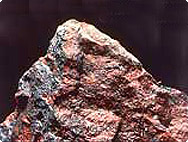A.Vogel search
When the internal search is activated, personal data such as your IP address is transmitted to our search engine Cludo. Data is thus transferred to a third country. Please click here if you want to display the internal search. You can find more information on data protection here: Privacy policy.
Cinnabaris
Red Mercuric Sulfure
History

Cinnabar, or red mercuric sulphide, was used as far back as the pre-Mycenaean Bronze Age around 2000 BC to colour paint. Since it represents one of the few naturally occurring mercury compounds, its history is closely associated with that of mercury, which has been used throughout the centuries. Mercury has been extracted from cinnabar since the 1st century. Burning off the sulphur contained in the compound converted the mercury into a highly poisonous vapour which was then condensed in the pure form (HgS + O2 → Hg + SO2). The miners and workers of the world’s largest mercury mines in Sisapo (= Almadén) in Spain and Idria in Slovenia soon displayed typical signs of mercury poisoning and their condition was documented at length by Dioscorides. Symptoms of chronic mercury poisoning such as shaky handwriting (a result of damage to the nervous system), suppurating infections of the maxillary and frontal sinuses, skin rashes and syphilitic type ulcers were typical ailments for mirror makers, gilders and milliners even into the last century. The use of mercury is still an issue today as, until recently, it was used in disinfectants, and amalgam containing mercury is still used in dentistry today.The use of mercury in medicine is almost as old as cases of poisoning. In the 9th century, Arabian doctors used ointments containing mercury to treat skin infections as well as parasitic, eczematous and leprous infections. Inunction treatment using ointments containing mercury (grey salve) were applied to treat syphilis when the ‘French disease‘, as it was known then, began to spread from country to country around 1490.In persistent cases fumigations of cinnabar were used. For this, the patient was placed naked in a barrel-like construction - fortunately the head was allowed to remain outside - and 15g to 30g of cinnabar was heated on red hot coals beneath him. This procedure was repeated between six to nine times until the patient began to salivate and get diarrhoea. It was believed that by so doing the venereal poison would be drawn out of the body. Many patients died in agony as a result of this murderous practice. The term ‘quack’, referring to an unqualified doctor, is derived from these practices. It was not until Hahnemann produced his own mercury compound, known as ‘mercurius solubilis Hahnemanni‘, that the transformation from poison to remedy was made. In Egypt around the 3rd century the study of alchemy began to establish itself, according to which both metals and the human body consisted of mercury and sulphur. Mercury was regarded as the carrier of volatility and of fusibility. It provided the metallic nature while sulphur provided the characteristic of combustibility. It was on account of this substance's volatility and quick action that Mercury the winged messenger of the gods was adopted as its symbol. Up until well into the 18th century Mercurius was to play a key role as ‘mother of the seven metals‘ and as the female principle in alchemy. Sulphur was regarded as the male principle. Alchemists called mercury Mercurius from the 13th century and this is still its homoeopathic name today. The name hydrargyrum comes from the Greek word hydragyros and means ‘liquid silver‘. The Romans called it argentum vivum, meaning ‘lively silver‘. The English and German terms ‘quicksilver’ and ‘Quecksilber’ originate from the Middle High German term queck, meaning lively, similarly to the English word quick.The Greek word kinnábari (cinnabar) is apparently derived from the Arabic word apar (red dust), which is possibly of Indian or Persian origin. The Roman term for cinnabar was ‘minium‘. Cinnabar was an expensive pigment used for painting and was often adulterated by adding red lead or lead oxide. The name minium which is etymologically related to the word for red lead soon became interchangeable with its surrogate.
Physical Characteristics
Red mercuric sulphide is a mineral that either occurs in its scarlet-red version (cinnabar) in hexagonal crystals or as a black form consisting of tiny, tetrahedral crystals. Cinnabaris is extremely difficult to dissolve in water and only dissolves very slowly even in concentrated mineral acids. Its molecular formula is HgS and its molecular weight is 232.7.
Occurrence
Cinnabar is the most frequent naturally occurring mercury compound. It can be found either pure, or mixed together with other minerals. In most cases Cinnabar is to be found as a deposit remaining from hot, aqueous solutions during periods of volcanic activity. It is largely found in Almadén in Spain, Idria in Slovenia, Italy, Peru, California, Mexico, Japan and Russia. The vast proportion of Cinnabar is, however, produced artificially from mercury and sulphur using various methods.
Preparation
A.Vogel/Bioforce uses a homoeopathic trituration produced from hydragyrum sulfuratum rubrum, extracted from the naturally occurring mineral cinnabarite which contains at least 90 % HgS.
A.Vogel Blog – Natural and Healthy
Inspiration for a healthy life!



